
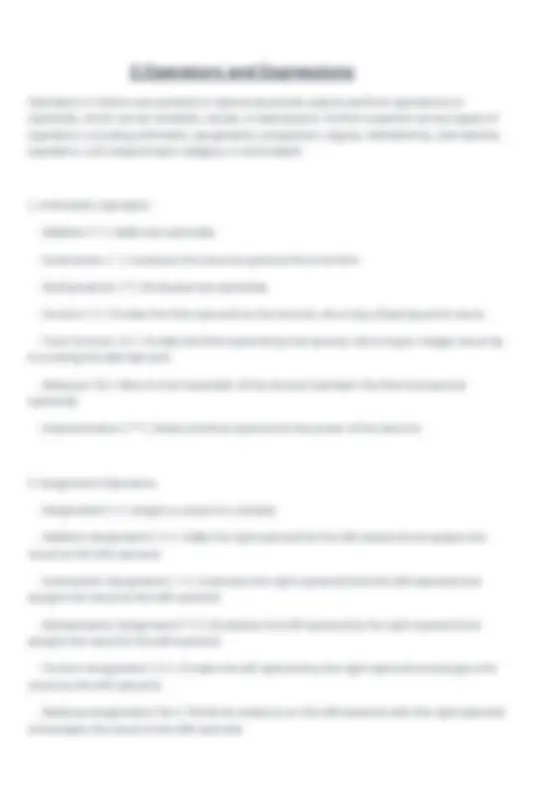
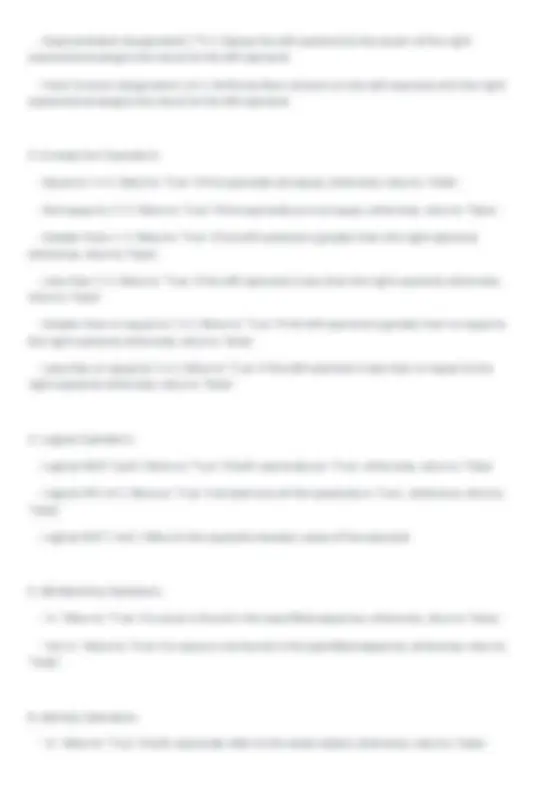
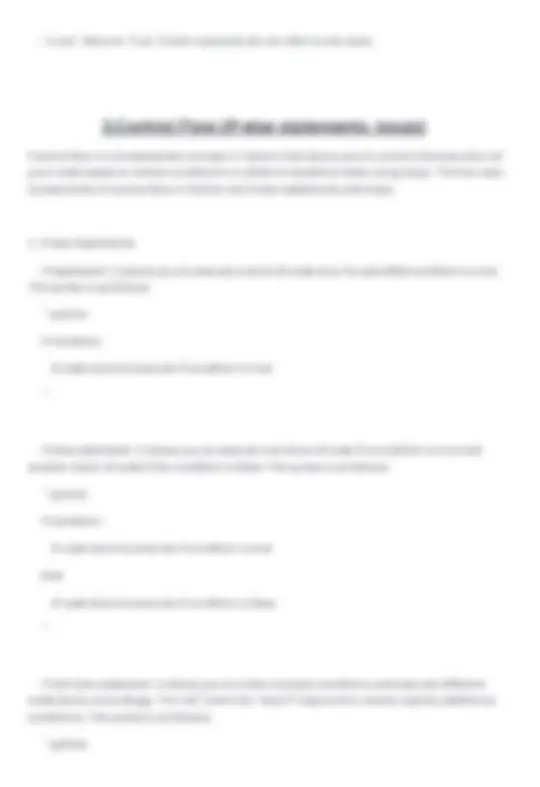
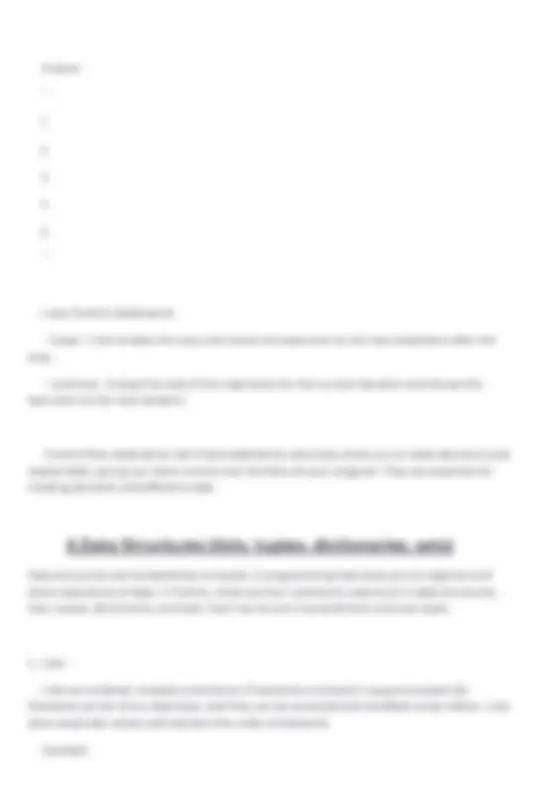
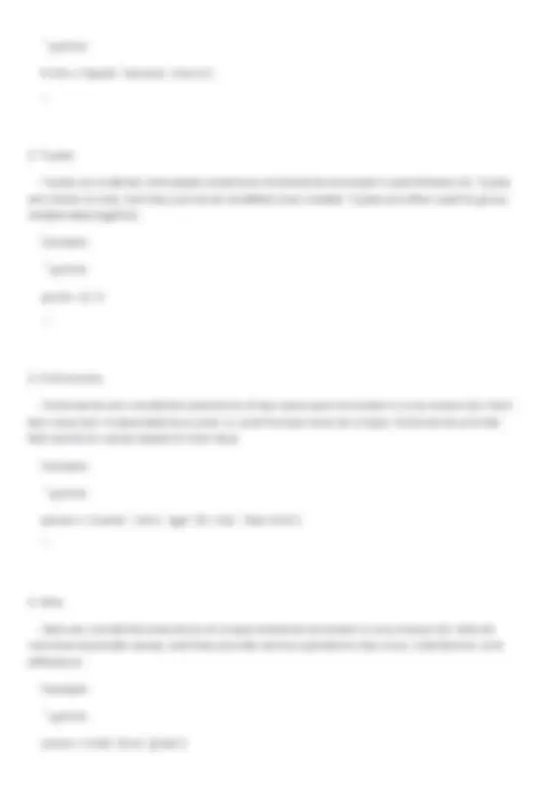
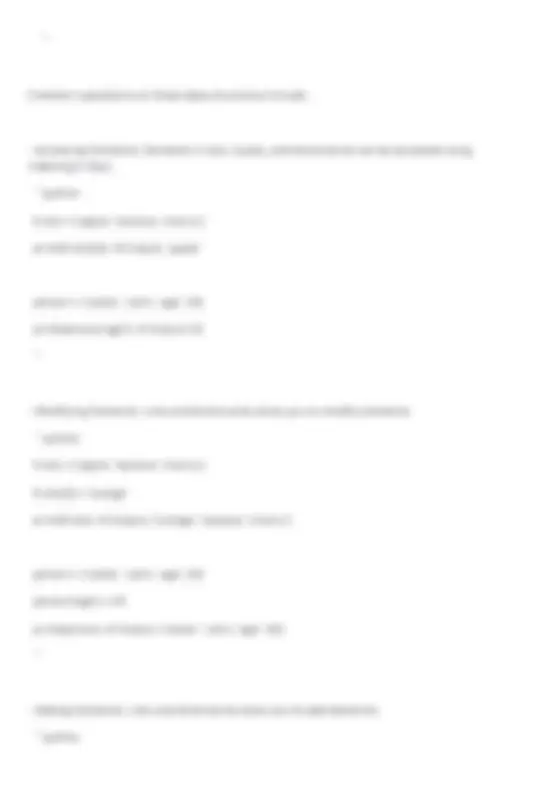

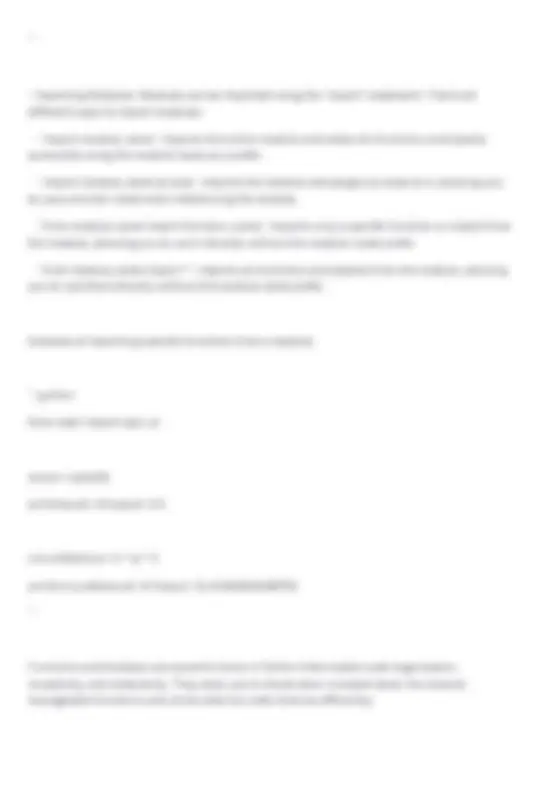
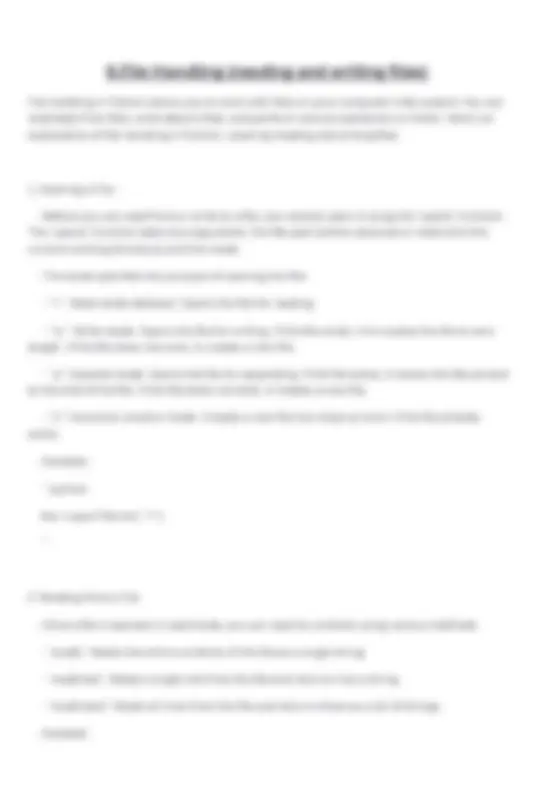

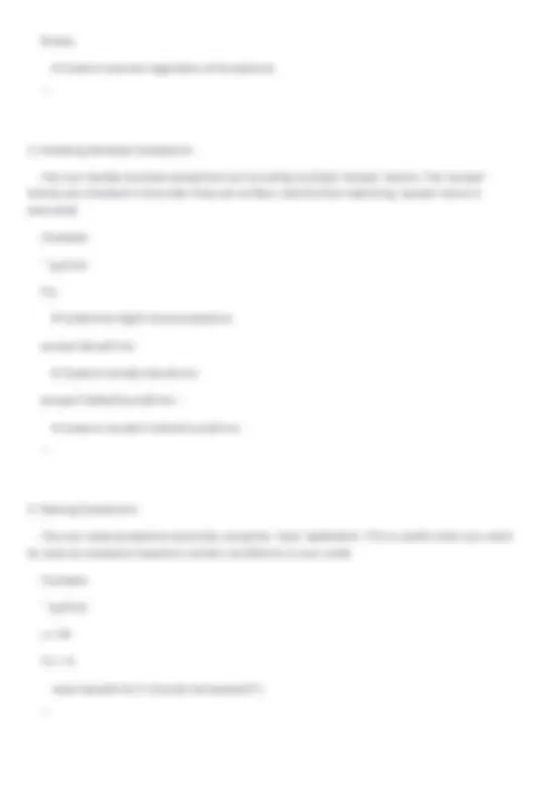

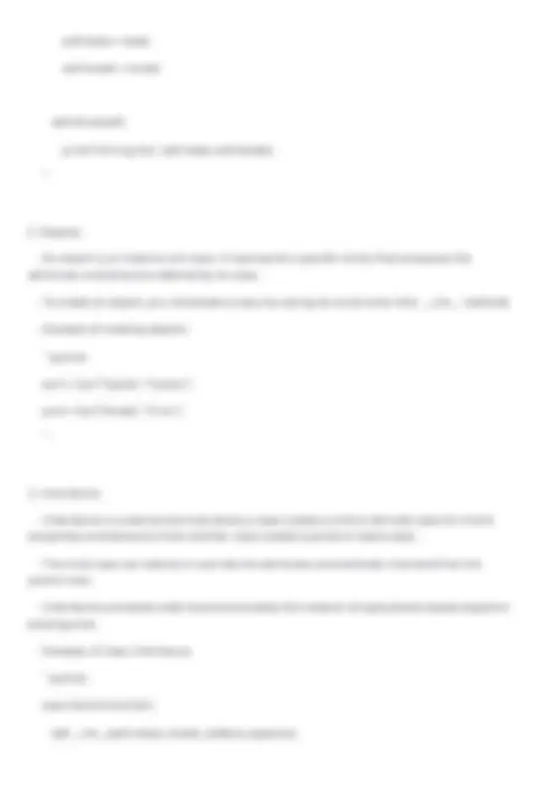
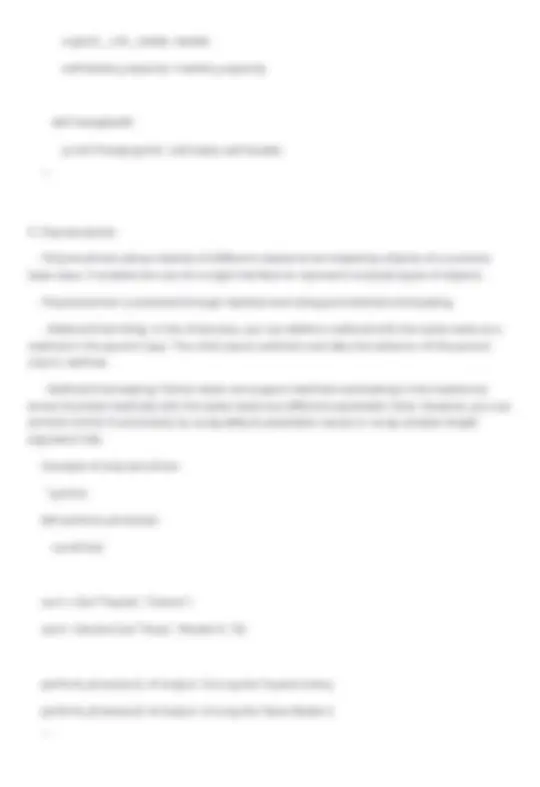
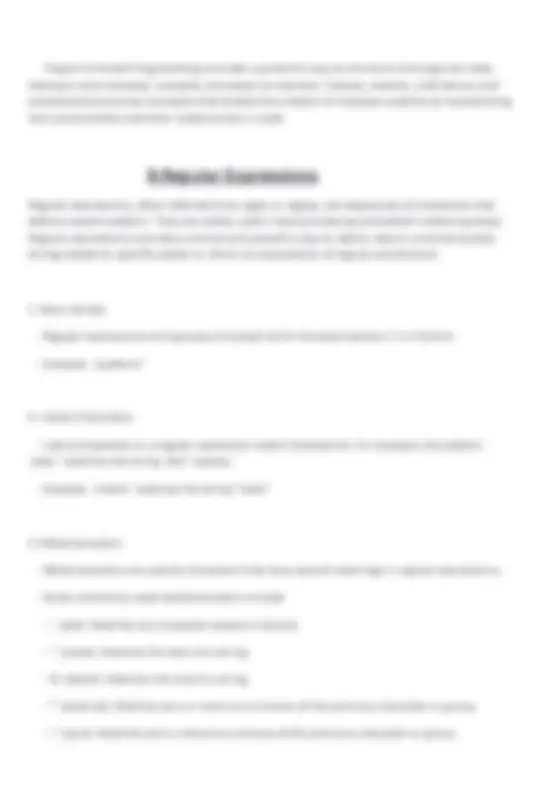
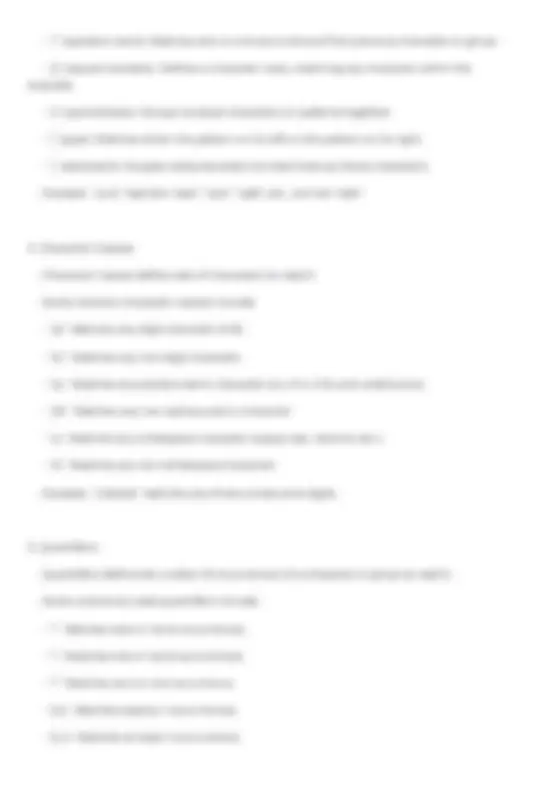
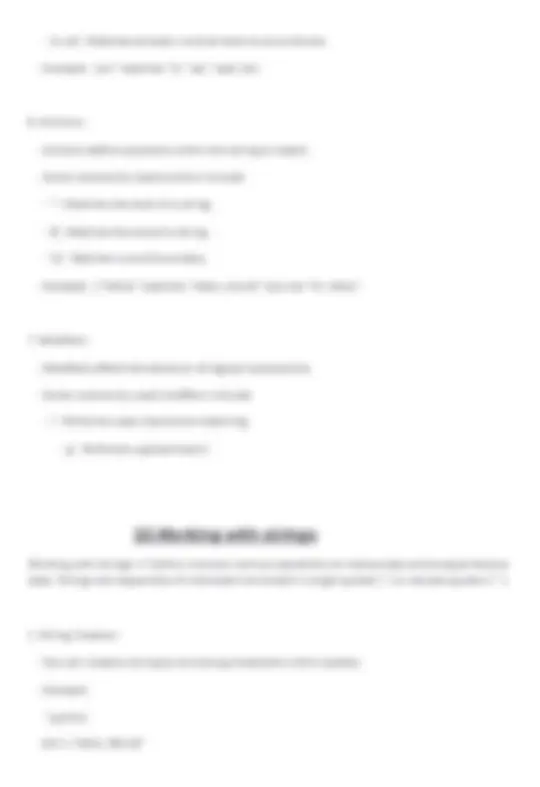
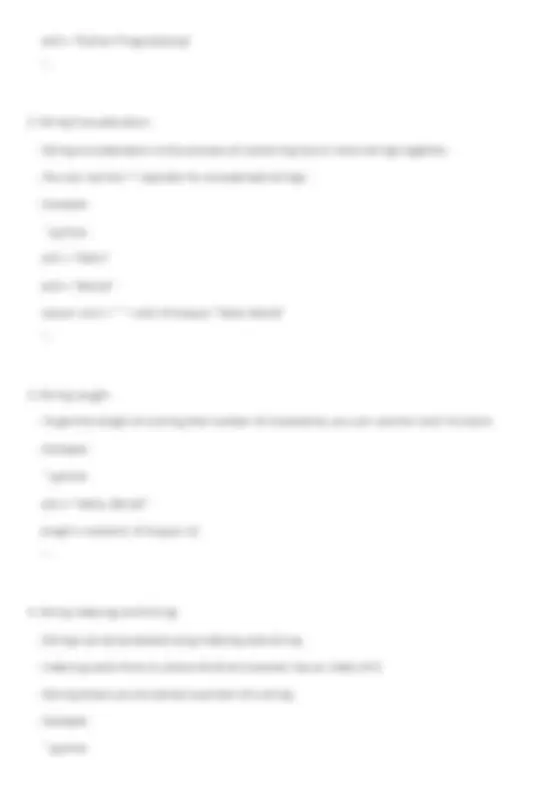
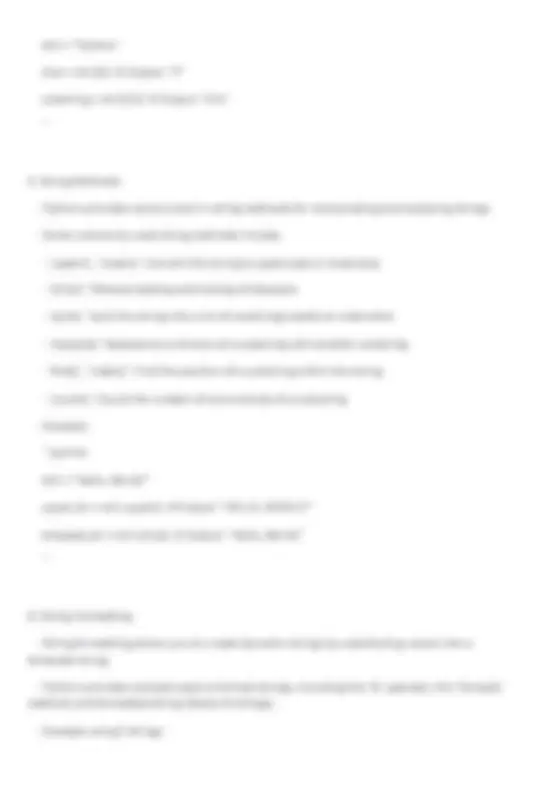
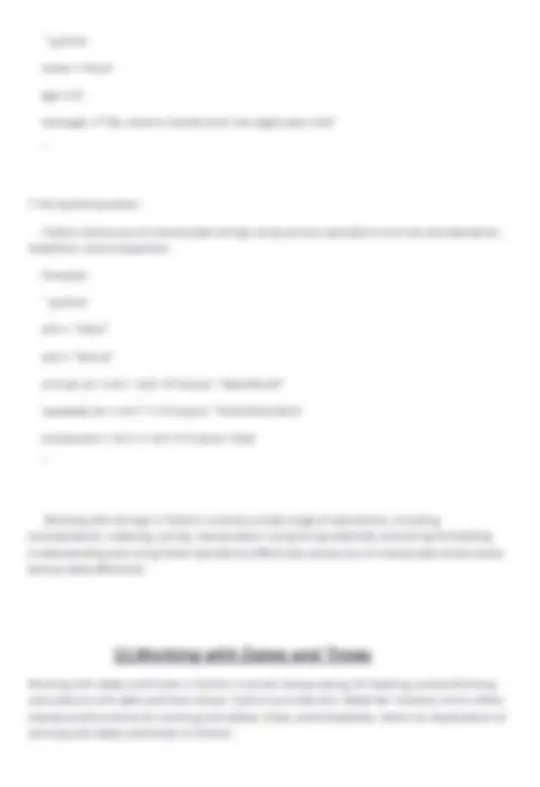
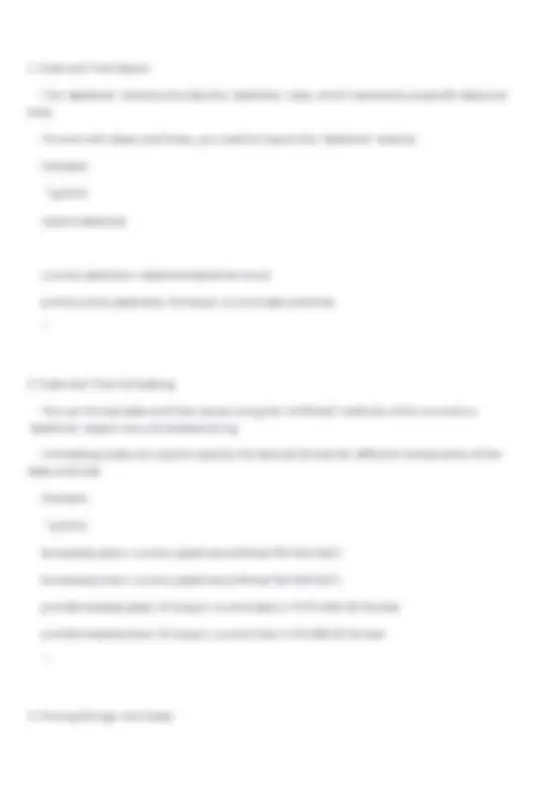
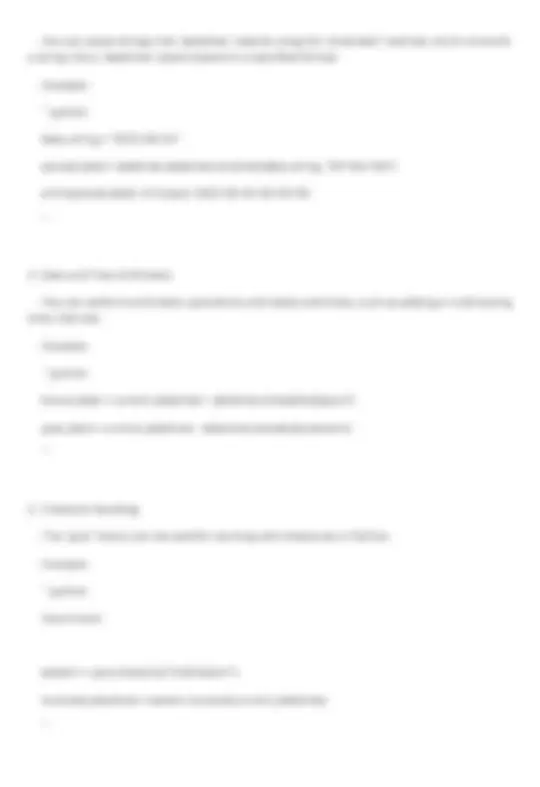
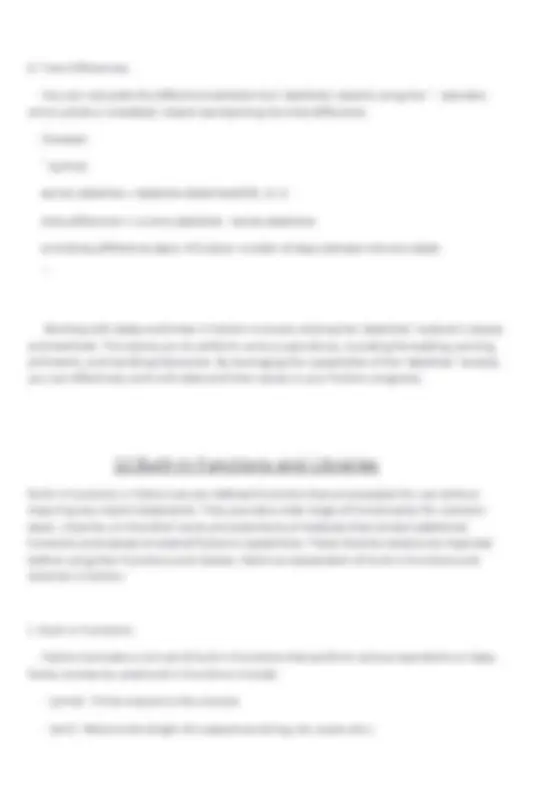
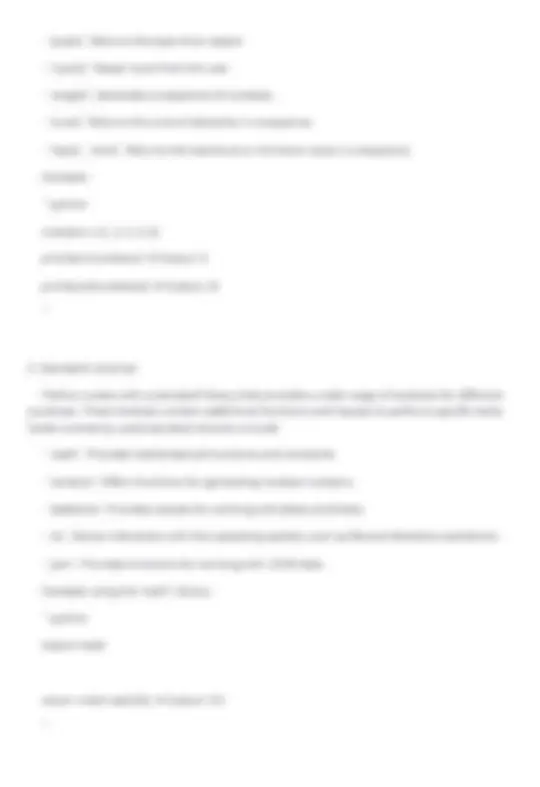
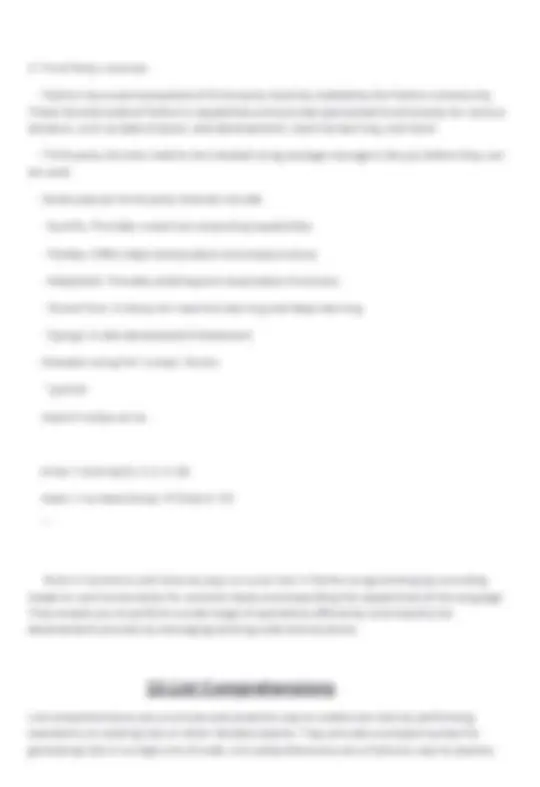
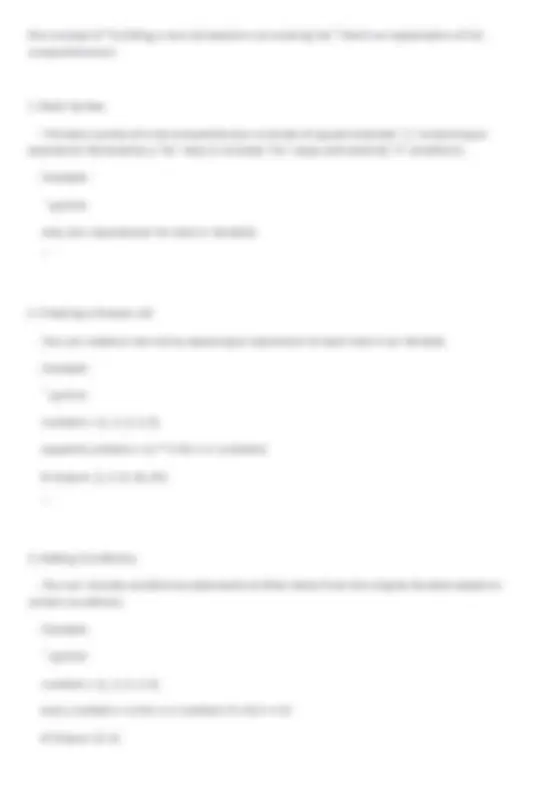
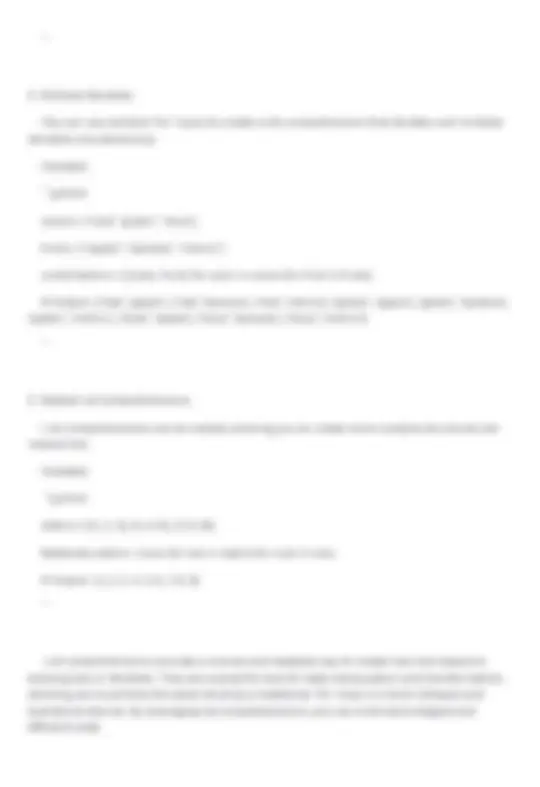
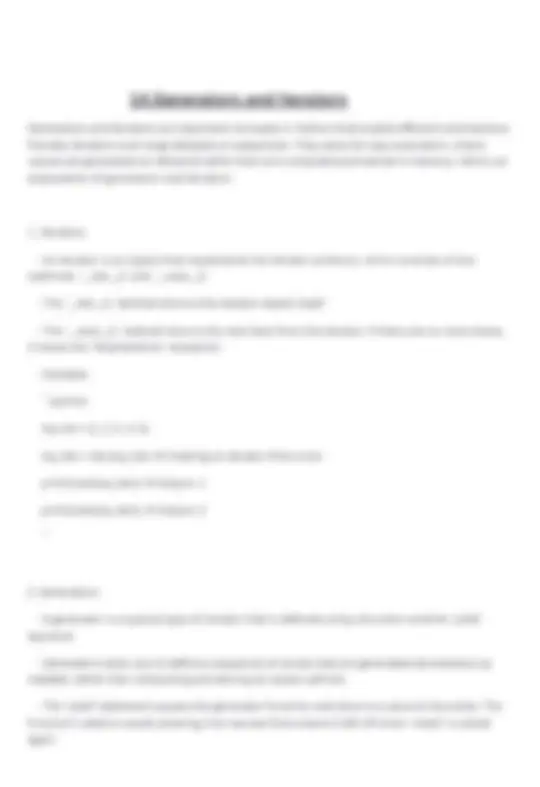
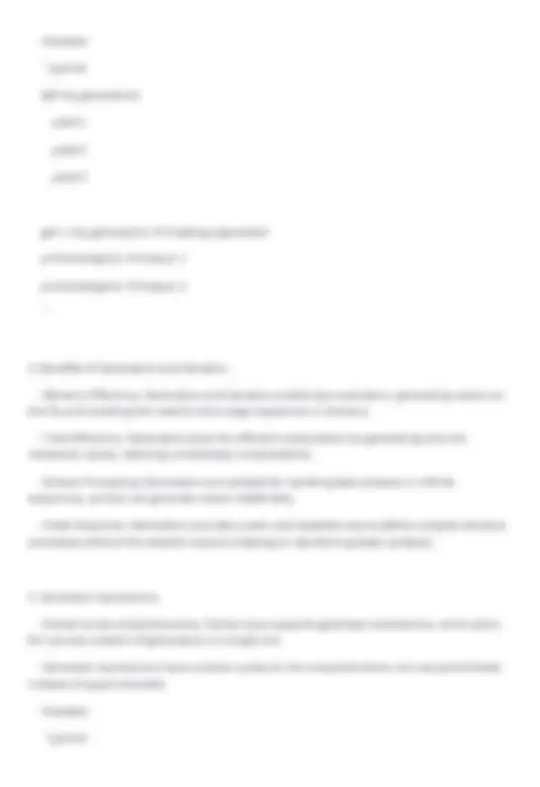
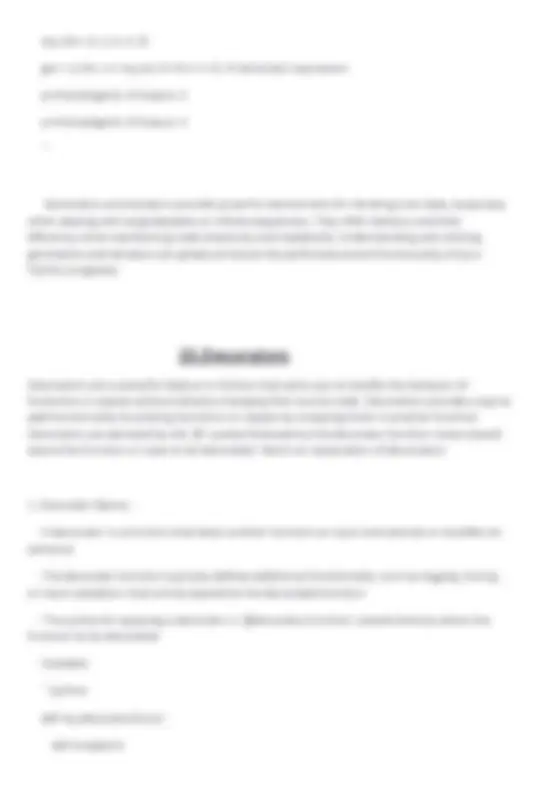

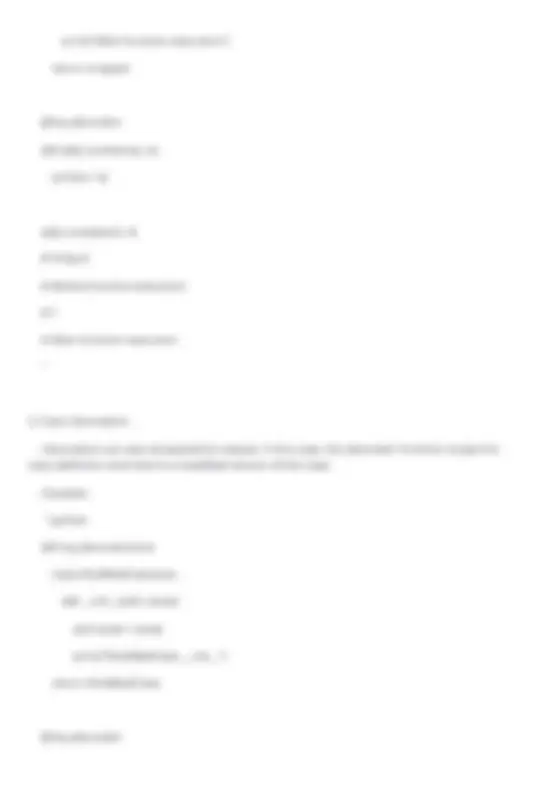
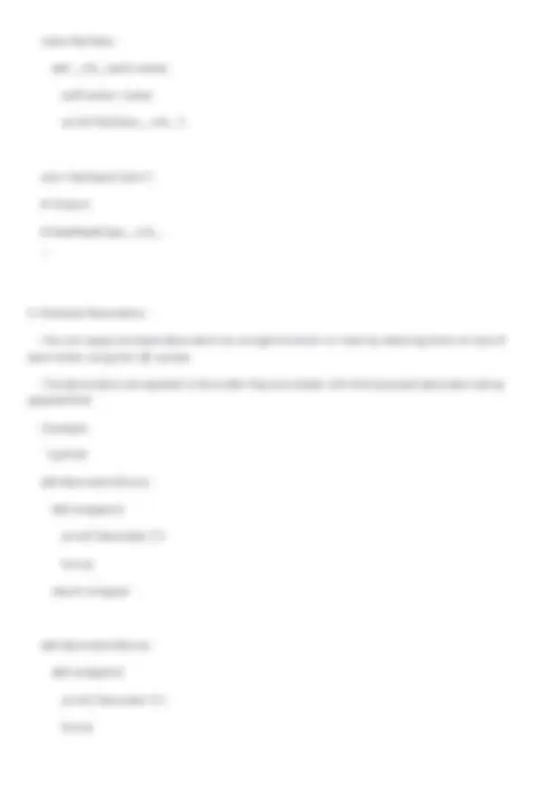

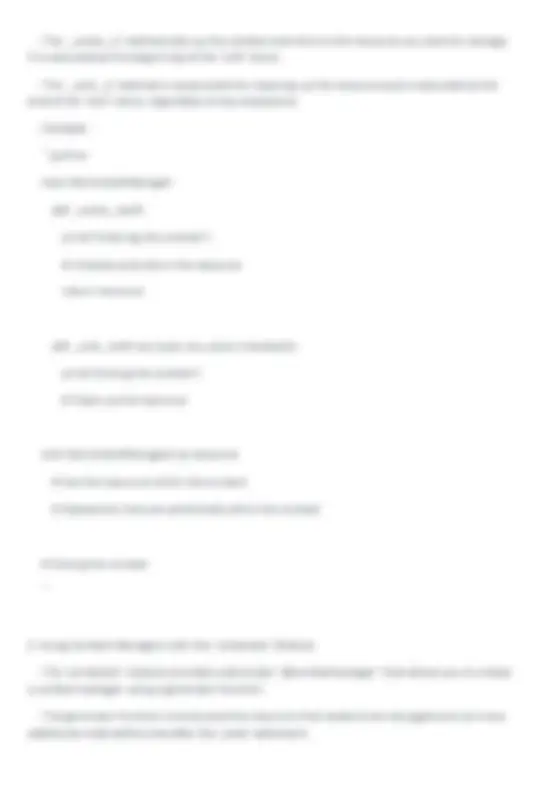






Study with the several resources on Docsity

Earn points by helping other students or get them with a premium plan


Prepare for your exams
Study with the several resources on Docsity

Earn points to download
Earn points by helping other students or get them with a premium plan
Community
Ask the community for help and clear up your study doubts
Discover the best universities in your country according to Docsity users
Free resources
Download our free guides on studying techniques, anxiety management strategies, and thesis advice from Docsity tutors
"Python Programming Essentials" is a comprehensive guide that covers all essential topics of Python programming. It delves into variables, data types, control flow, data structures, functions, file handling, object-oriented programming, regular expressions, and more. With clear explanations, practical examples, and code snippets, this resource equips beginners and intermediate learners with a solid understanding of Python. Whether you're interested in web development, data analysis, or automation, these notes provide the knowledge needed to tackle real-world projects. Packed with insights and tips, this guide is a valuable companion for anyone seeking to unlock the full potential of Python and accelerate their programming journey.
Typology: Study notes
1 / 47

This page cannot be seen from the preview
Don't miss anything!








































Topics Covered:-
In Python, variables are used to store data values. They act as placeholders that can be assigned values of di�erent data types. Each variable has a name, which is used to access and manipulate the stored value. Python is dynamically typed, which means you don't need to declare the data type of a variable explicitly. Instead, the data type is inferred automatically based on the value assigned to it. Data types in Python represent the kinds of values that variables can hold. Python has several built-in data types, including:
Variables can be assigned values using the assignment operator (=). For example: x = 10 # assigning an integer value to x name = 'John' # assigning a string value to name numbers = [1, 2, 3, 4] # assigning a list to numbers Python allows variables to be reassigned to di�erent values, even with di�erent data types. The data type of a variable can change dynamically during the execution of a program. x = 10 print(x) # Output: 10 x = 'Hello' print(x) # Output: Hello Understanding variables and data types is fundamental to Python programming, as they form the basis for storing and manipulating information within a program. Strings (str): Sequences of characters enclosed in single quotes ('') or double quotes (""). For example, "Hello, World!" or 'Python'.
**=): Raises the left operand to the power of the right operand and assigns the result to the left operand.//=): Performs floor division on the left operand with the right operand and assigns the result to the left operand.==): Returns True if the operands are equal; otherwise, returns False.!=): Returns True if the operands are not equal; otherwise, returns False.>): Returns True if the left operand is greater than the right operand; otherwise, returns False.<): Returns True if the left operand is less than the right operand; otherwise, returns False.>=): Returns True if the left operand is greater than or equal to the right operand; otherwise, returns False.<=): Returns True if the left operand is less than or equal to the right operand; otherwise, returns False.and): Returns True if both operands are True; otherwise, returns False.or): Returns True if at least one of the operands is True; otherwise, returns False.not): Returns the opposite boolean value of the operand.in: Returns True if a value is found in the specified sequence; otherwise, returns False.not in: Returns True if a value is not found in the specified sequence; otherwise, returns False.is: Returns True if both operands refer to the same object; otherwise, returns False.is not: Returns True if both operands do not refer to the sameControl flow is a fundamental concept in Python that allows you to control the execution of your code based on certain conditions or perform repetitive tasks using loops. The two main components of control flow in Python are if-else statements and loops.
if condition: # code block to execute if condition is true if condition: # code block to execute if condition is true else: # code block to execute if condition is false elif (short for "else if") keyword is used to specify additional conditions. The syntax is as follows: numbers = [1, 2, 3, 4, 5] for number in numbers: print(number)
Output: 1 2 3 4 5
- Range function: It is often used with for loops to generate a sequence of numbers. The `range()` function generates a sequence of numbers from a starting value to an ending value (exclusive) with a specified step size. The syntax is as follows: ```python for i in range(start, stop, step): # code block to execute For example:
for i in range(1, 6): print(i) Output:
1 2 3 4 5 break: It terminates the loop and moves the execution to the next statement after the loop.continue: It skips the rest of the code block for the current iteration and moves the execution to the next iteration. Control flow statements like if-else statements and loops allow you to make decisions and repeat tasks, giving you more control over the flow of your program. They are essential for creating dynamic and e�cient code.Data structures are fundamental concepts in programming that allow you to organize and store collections of data. In Python, there are four commonly used built-in data structures: lists, tuples, dictionaries, and sets. Each has its own characteristics and use cases.
Common operations on these data structures include:
fruits = ['apple', 'banana', 'cherry'] print(fruits[0]) # Output: 'apple' person = {'name': 'John', 'age': 25} print(person['age']) # Output: 25 fruits = ['apple', 'banana', 'cherry'] fruits[0] = 'orange' print(fruits) # Output: ['orange', 'banana', 'cherry'] person = {'name': 'John', 'age': 25} person['age'] = 30 print(person) # Output: {'name': 'John', 'age': 30} fruits = ['apple', 'banana', 'cherry'] fruits.append('orange') print(fruits) # Output: ['apple', 'banana', 'cherry', 'orange'] person = {'name': 'John', 'age': 25} person['city'] = 'New York' print(person) # Output: {'name': 'John', 'age': 25, 'city': 'New York'}
- Removing Elements: Lists, tuples, and dictionaries provide methods to remove elements. ```python fruits = ['apple', 'banana', 'cherry'] fruits.remove('banana') print(fruits) # Output: ['apple', 'cherry'] person = {'name': 'John', 'age': 25} del person['age'] print(person) # Output: {'name': 'John'} ``` These data structures are versatile and can be combined to represent complex data structures and solve various programming problems. ## 5.Functions and Modules Functions and modules are essential components of modular programming in Python. They help organize code into reusable and manageable units, promoting code reusability, readability, and maintainability. - Return Statement: Functions can optionally return a value using the `return` statement. The return value can be assigned to a variable or used directly in the code. Example of a function with a return statement: ```python def add(a, b): return a + b result = add(3, 5) print(result) # Output: 8 Modules: A module is a file containing Python definitions and statements. It serves as a way to organize related code into separate files, making it easier to manage and reuse code. Modules can contain functions, classes, variables, and other Python objects. To use a module, it needs to be imported into your code. Example of importing a module and using its function:
# Importing the math module import math # Using the math module's function result = math.sqrt(16) print(result) # Output: 4. #### ``` - Importing Modules: Modules can be imported using the `import` statement. There are di�erent ways to import modules: - `import module_name`: Imports the entire module and makes its functions and objects accessible using the module name as a prefix. - `import module_name as alias`: Imports the module and assigns an alias to it, allowing you to use a shorter name when referencing the module. - `from module_name import function_name`: Imports only a specific function or object from the module, allowing you to use it directly without the module name prefix. - `from module_name import *`: Imports all functions and objects from the module, allowing you to use them directly without the module name prefix. Example of importing specific functions from a module: ```python from math import sqrt, pi result = sqrt(25) print(result) # Output: 5. circumference = 2 * pi * 5 print(circumference) # Output: 31. Functions and modules are powerful tools in Python that enable code organization, reusability, and modularity. They allow you to break down complex tasks into smaller, manageable functions and utilize external code libraries e�ciently.
file = open("file.txt", "r") content = file.read() print(content) file.close() write() method. The write() method writes a string to the file.file = open("file.txt", "w") file.write("Hello, World!") file.close() write() method without truncating the existing contents.file = open("file.txt", "a") file.write("\nThis is a new line.") file.close() file = open("file.txt", "r") # Perform file operations file.close() To simplify file handling and ensure proper handling of resources, it is recommended to use the with statement. The with statement automatically closes the file once you are done with it, even if an exception occurs within the block. Example:
with open("file.txt", "r") as file: content = file.read() print(content) File handling in Python allows you to work with files, read data from them, write data to them, and perform various file-related operations. Proper handling and closing of files are important to ensure e�cient and safe file operations.
Exception handling in Python allows you to handle and manage errors or exceptional situations that may occur during the execution of a program. By using exception handling,
finally:
3. Handling Multiple Exceptions: - You can handle multiple exceptions by including multiple `except` blocks. The `except` blocks are checked in the order they are written, and the first matching `except` block is executed. - Example: ```python try: # Code that might raise exceptions except ValueError: # Code to handle ValueError except FileNotFoundError: # Code to handle FileNotFoundError ``` 4. Raising Exceptions: - You can raise exceptions explicitly using the `raise` statement. This is useful when you want to raise an exception based on certain conditions in your code. - Example: ```python x = 10 if x > 5: raise ValueError("x should not exceed 5") ``` 5. Handling Exceptions with Context Managers: - Python provides the `with` statement, also known as a context manager, for managing resources that need to be cleaned up automatically. Context managers are commonly used with files, database connections, and other resources. - Example using file handling: ```python with open("file.txt", "r") as file: # Code to read from the file ``` Exception handling allows you to handle errors gracefully and provides better control over the flow of your program. By handling exceptions, you can prevent unexpected crashes and ensure that your program handles errors in a controlled manner. ### 8.Object-Oriented Programming ### (classes,objects,inheritance,polymorphism) Object-Oriented Programming (OOP) is a programming paradigm that organizes code into objects, which are instances of classes. OOP focuses on modeling real-world entities as objects and provides concepts like encapsulation, inheritance, and polymorphism. Here's an explanation of the key concepts in OOP: 1. Classes: - A class is a blueprint or a template that defines the properties (attributes) and behaviors (methods) of objects. It encapsulates data and functions into a single unit. Objects are instances of classes. - Example of a class definition: ```python class Car: def __init__(self, make, model):